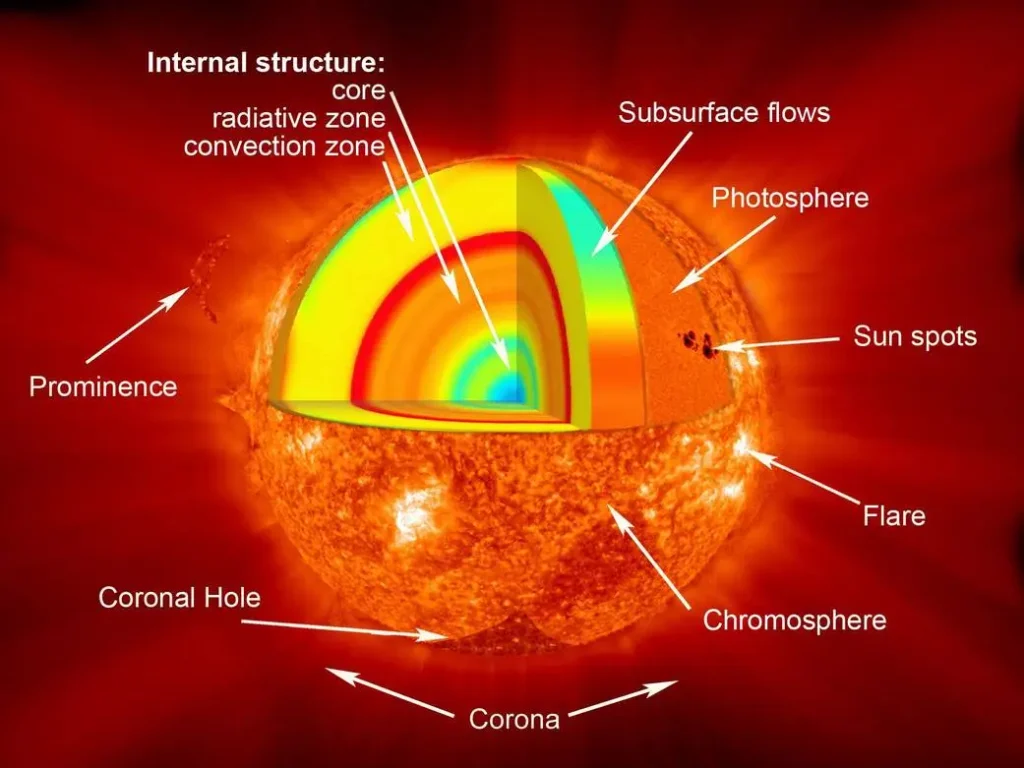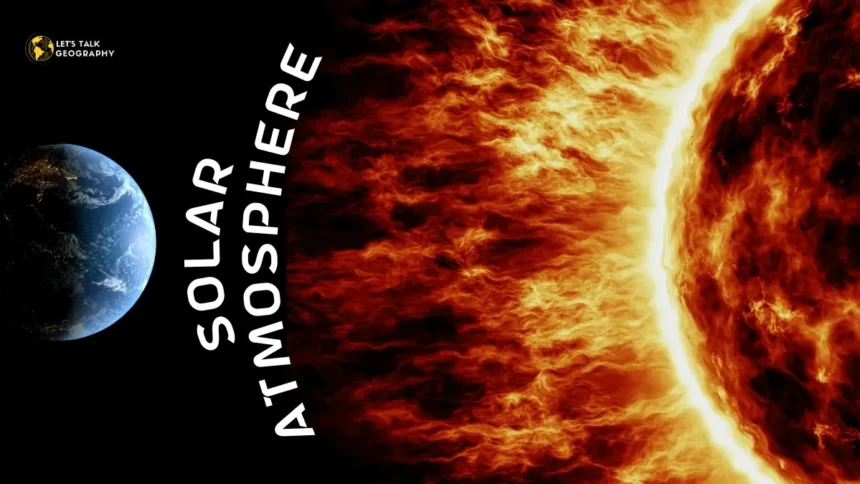Introduction:
Have you ever marveled at the blazing sun and wondered what mysteries lie within its brilliant layers?
The solar atmosphere is a captivating and complex region that allows us to understand the sun’s behavior and impact on the solar system. Comprising the photosphere, chromosphere, and corona, the solar atmosphere is the source of fascinating phenomena such as solar storms, flares, and eclipses. Studying the solar atmosphere helps scientists predict space weather that can affect Earth and advances our knowledge of solar energy and its potential. As we delve deeper into the layers and activities of the solar atmosphere, we uncover the dynamic processes that drive the sun and influence our daily lives.
Structure of the Solar Atmosphere:
◆ Photosphere:
From much of its emitted energy, the visible part of the sun goes directly to the Earth. In reality, the Sun has no surface. Just because the sun is so far from the Earth, it seems slightly sharp to the naked eye. The photosphere is a flat layer that is quite 400 km thick.
The temperatures in this layer range from 4400 kelvins at the top to 10000 K at the bottom. Photos introduced into it cannot escape without absorption and remission. The ionized gas density is about 1/1000 that of air at the earth’s surface, which is quite opaque because of the taking in of hydrogen ions.
Characteristics and Features: There is a region devoid of darkening towards the outer side, known as limb darkening. Towards the end, light comes from higher up in the atmosphere, with low temperature and weak radiation. Each granule or cell is a weight of hot gas 1000 km in diameter, the granules that rise because of convection in the sun.
◆ Chromosome:
It is the lowest level of the ambiance of the sun, which is a lot of kilometers in thickness, over the bright photosphere and lower the extremely tenuous corona. The chromosphere, termed by the English astronomer Sir Joseph Norman Lockyer, appears as a bright crescent, red with hydrogen light, during the eclipse of the sun when the Moon guards the sun’s body.
At other times, the chromosphere can be seen across the sun’s face through the red light of the hydrogen alpha line.

Role in Solar Activity: Columns of ascending gas known as spicules from the below-level chromosphere have been hotter gas, which is quite relevant to the corona, in which the upper chromosomes get linked one after the other. Temperatures range between 4500 and 100000 K and rise with altitude; the average temperature is about 6000 K.
◆ Corona:
It is the outermost region of the ambiance of the sun that includes the plasma. It has a temperature of millions of kelvins and very low density. It mainly varies in size and shape as the Sun’s magnetic field influences it. The solar wind flows radially outside through the total solar system, and if formed by the increase of the coronal gases, it only concludes at the heliopause.
Phenomena in the Solar Atmosphere:
◆ Solar Storms:
Solar storms are the atmospheric effects felt by specific effects that appear in the sun. Solar storms occur when the sun radiates a tremendous amount of energy that causes many solar flares and coronal ejections. These phenomena are a layer of electrical charges and magnetic fields moving at about three million miles per hour.
◆ Solar Flares:
A solar flare is a sudden, immediate, and intense variation in brightness that occurs when magnetic energy is present in the solar atmosphere. Radiation occurs through the electromagnetic spectrum from radio waves at a red wavelength. The first solar flare, recorded on September 1, 1859, released electrons, protons, and heavy nuclei that were heated most acceleratedly.
Solar Energy and Its Implications:
◆ Harnessing Solar Energy:
Radiation from the Sun is termed solar energy. This energy generates heat, which is used to generate electricity. The total value of solar energy is directed towards Earth, and it meets the world’s energy needs. The sun is a potent energy source, but its intensity at the Earth is very low, trapping radiation from the sun.

◆ Technologies and Innovations to Utilize Solar Energy:
Solar energy is used as a source of thermal energy. Solar panels are installed to convert solar energy into electricity. The most common devices for trapping solar energy and turning it into thermal energy are flat plate collectors, which are utilized for solar heating applications. Another method is solar ponds, bodies of salt water designed for collecting and storing solar energy. Another example is solar ovens.
Solar Eclipses: Windows to the Sun’s Mysterious Atmospheres
A solar eclipse is a celestial event in which the moon momentarily blocks the Sun’s light. Such an alignment appears when the moon’s orbital plane comes closest to the plane of the earth’s orbit. In a total eclipse, the sun’s disc is entirely blocked by the moon, unlike in a partial or annual eclipse, which is blocked.
Types of Solar Eclipse: Total, Partial, and Annular Eclipses
- A total eclipse occurs on an average of about 18 months when the bright sun blocks the moon’s dark silhouette, allowing a blurred solar corona to be visible. During an eclipse, the total appears on a bit of track of the earth’s surface.

- An annual eclipse occurs when the Sun and the Moon align with the Earth, and the Moon’s size is not large enough to completely clock out the Sun.
- A partial eclipse occurs twice a year when the sun and the moon are not entirely in one line with the Earth, and the Moon partially blocks the sun.
Solar Eclipses Illuminate the Sun’s Hidden Layers
A solar eclipse is more than just a celestial spectacle. It’s a golden opportunity for scientists to study the outer solar atmospheres, normally obscured by the blinding light of the photosphere (the Sun’s visible surface). Modern eclipse studies continue to provide valuable data.
As technology advances, scientists are developing new tools to maximize the scientific value of each eclipse. Space-based observatories, like NASA’s Parker Solar Probe and the European Space Agency’s Solar Orbiter, complement eclipse observations by providing continuous data on the solar atmospheres and activity. However, eclipses remain an essential tool for unraveling the Sun’s mysteries.
Conclusion:
The solar atmosphere is an extraordinary and intricate region that significantly enhances our understanding of the sun’s dynamic behavior and influence on our solar system. By exploring its layers—the photosphere, chromosphere, and corona—we gain insight into powerful phenomena such as solar storms, solar flares, and solar eclipses. These events affect space weather and have practical implications for solar energy harnessing and technological advancements.
Understanding the solar atmosphere is vital as it helps predict and mitigate space weather’s impacts on Earth. As we continue to study and uncover its secrets, we enhance our ability to harness solar energy and protect our planet from potential solar threats. The knowledge gained from studying the solar atmosphere is essential for advancing scientific research and securing a sustainable future for humanity.
FAQs:
1. What is the solar atmosphere?
The solar atmosphere is the sun’s outer layer, consisting of the photosphere, chromosphere, and corona. It is where most solar activity occurs, including the emission of light and heat, solar flares, and coronal mass ejections. The solar atmosphere influences space weather and the Earth’s climate.
2. What are the main layers of the solar atmosphere?
The solar atmosphere is composed of three main layers:
- Photosphere: The visible surface of the sun, where sunlight is emitted.
- Chromosphere: The layer above the photosphere, known for its reddish glow during solar eclipses.
Corona: The outermost layer, characterized by its high temperatures and extended structure visible during total solar eclipses.
3. How do solar flares affect Earth?
Solar flares are sudden eruptions of energy on the sun’s surface that release intense radiation. They can affect Earth by disrupting communications, navigation systems, and power grids. Solar flares also enhance the auroras (Northern and Southern Lights) and pose risks to astronauts and satellites due to increased radiation levels.
4. What causes solar storms?
Solar activity, such as variations of solar flares and coronal mass ejections (CMEs), may result in solar storms. During events, large amounts of charged particles and magnetic fields are released into space, which can interact with the Earth’s magnetosphere. Solar storms can lead to geomagnetic disturbances, affecting satellites, power grids, and communication systems.
5. How is solar energy harnessed?
Solar energy is harnessed using photovoltaic (PV) cells that convert sunlight into electricity. Solar panels, composed of numerous PV cells, are installed on rooftops, fields, or solar farms to capture and convert solar energy. As a renewable energy source, solar energy can replace fossil fuels, decreasing greenhouse gas emissions and providing a sustainable energy solution.
5. What is the significance of solar eclipses?
Solar eclipses are celestial events that occur when the moon blocks the visibility of the Sun while passing between the Earth and the Sun. They are significant for scientific research as they allow astronomers to study the solar corona and other features of the sun’s atmosphere. Solar eclipses also have cultural and historical importance, inspiring myths, legends, and scientific curiosity throughout history.
References:
- Zirin, H. (2023). photosphere. In Encyclopedia Britannica.
- The Editors of Encyclopedia Britannica. (2024a). Corona. In Encyclopedia Britannica.
- Ashok, S. (2024). Solar energy. In Encyclopedia Britannica.
- Crail, C. (2024, May 2). Solar energy pros and cons: What are the advantages and disadvantages? Forbes. https://www.forbes.com/home-improvement/solar/solar-energy-pros-and-cons/
- What is a solar storm? (n.d.). Wonderopolis.org. Retrieved May 30, 2024, from https://www.wonderopolis.org/wonder/what-is-a-solar-storm/
- Solar Flares. (n.d.). Nasa.gov. Retrieved May 30, 2024, from https://hesperia.gsfc.nasa.gov/sftheory/flare.htm

